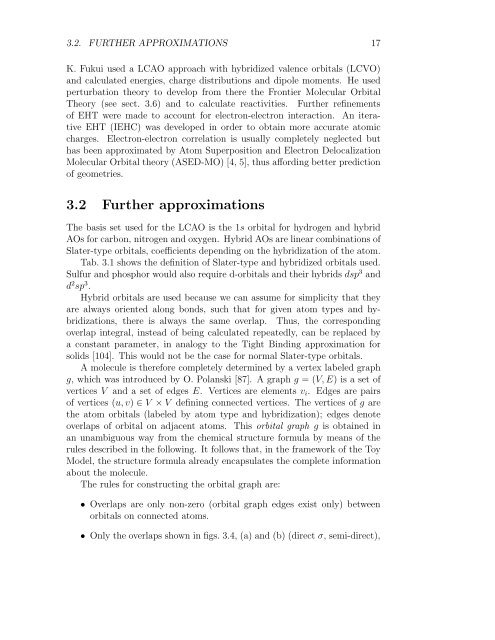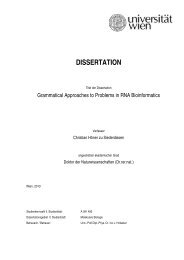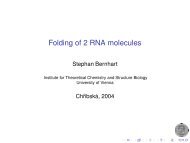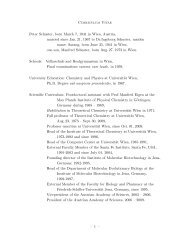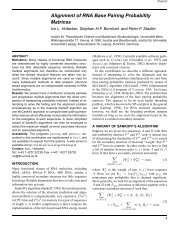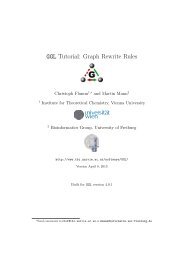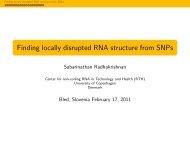A Toy Model of Chemical Reaction Networks - TBI - Universität Wien
A Toy Model of Chemical Reaction Networks - TBI - Universität Wien
A Toy Model of Chemical Reaction Networks - TBI - Universität Wien
Create successful ePaper yourself
Turn your PDF publications into a flip-book with our unique Google optimized e-Paper software.
3.2. FURTHER APPROXIMATIONS 17<br />
K. Fukui used a LCAO approach with hybridized valence orbitals (LCVO)<br />
and calculated energies, charge distributions and dipole moments. He used<br />
perturbation theory to develop from there the Frontier Molecular Orbital<br />
Theory (see sect. 3.6) and to calculate reactivities. Further refinements<br />
<strong>of</strong> EHT were made to account for electron-electron interaction. An iterative<br />
EHT (IEHC) was developed in order to obtain more accurate atomic<br />
charges. Electron-electron correlation is usually completely neglected but<br />
has been approximated by Atom Superposition and Electron Delocalization<br />
Molecular Orbital theory (ASED-MO) [4, 5], thus affording better prediction<br />
<strong>of</strong> geometries.<br />
3.2 Further approximations<br />
The basis set used for the LCAO is the 1s orbital for hydrogen and hybrid<br />
AOs for carbon, nitrogen and oxygen. Hybrid AOs are linear combinations <strong>of</strong><br />
Slater-type orbitals, coefficients depending on the hybridization <strong>of</strong> the atom.<br />
Tab. 3.1 shows the definition <strong>of</strong> Slater-type and hybridized orbitals used.<br />
Sulfur and phosphor would also require d-orbitals and their hybrids dsp 3 and<br />
d 2 sp 3 .<br />
Hybrid orbitals are used because we can assume for simplicity that they<br />
are always oriented along bonds, such that for given atom types and hybridizations,<br />
there is always the same overlap. Thus, the corresponding<br />
overlap integral, instead <strong>of</strong> being calculated repeatedly, can be replaced by<br />
a constant parameter, in analogy to the Tight Binding approximation for<br />
solids [104]. This would not be the case for normal Slater-type orbitals.<br />
A molecule is therefore completely determined by a vertex labeled graph<br />
g, which was introduced by O. Polanski [87]. A graph g = (V, E) is a set <strong>of</strong><br />
vertices V and a set <strong>of</strong> edges E. Vertices are elements v i . Edges are pairs<br />
<strong>of</strong> vertices (u, v) ∈ V × V defining connected vertices. The vertices <strong>of</strong> g are<br />
the atom orbitals (labeled by atom type and hybridization); edges denote<br />
overlaps <strong>of</strong> orbital on adjacent atoms. This orbital graph g is obtained in<br />
an unambiguous way from the chemical structure formula by means <strong>of</strong> the<br />
rules described in the following. It follows that, in the framework <strong>of</strong> the <strong>Toy</strong><br />
<strong>Model</strong>, the structure formula already encapsulates the complete information<br />
about the molecule.<br />
The rules for constructing the orbital graph are:<br />
• Overlaps are only non-zero (orbital graph edges exist only) between<br />
orbitals on connected atoms.<br />
• Only the overlaps shown in figs. 3.4, (a) and (b) (direct σ, semi-direct),


